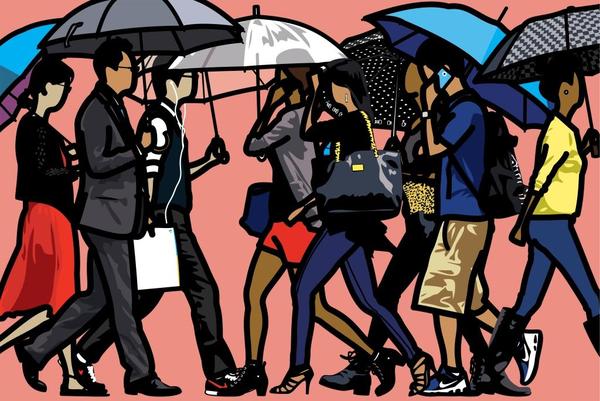
Tag Archives: opie
WOW – Work of the Week – OPIE, Professional Series I
|
|
||
|
Julian Opie Sizes are varied, specified below: About the work: Julian Opie is a master in the reductive style in that he still manages to capture the essence and individuality of each of his subjects. His works depict the world around us sharply, truly and timelessly The Professional Series 1, is no exception, Julian Opie observes people closely, and like a caricaturist, he has a formidable eye for foibles, idiosyncrasies and character. The paradox is that he renders these nuances in a flattened, abstract style that seems at first glance to be uniform and cold. In his Professional Series 1, people are portrayed in the classic Opie style, with bold black outlines, colorful clothes and no facial details at all. And yet, each professional seems individual and real. Professional Series 1 is printed on lenticular panels, in which a sequence of drawings are combined on tiny lenses so that as you move, you see them move. Stand still and the picture is still. Move and it is animated. These animated lenticular drawings richly analyze the nature of movement. |
WOW – Work Of the Week – Julian Opie “Walking In The Rain, Seoul”
WOW! – Work of the Week 6/22/15
Julian Opie, Walking in the Rain, London
Julian Opie
Walking in the Rain, London
2015
Screenprint on Somerset Satin tub sized 410 gsm paper
59 x 86 3/8 in.
Edition of 50
This piece is signed and numbered.
About This Work:
In his newer works, like Walking in the Rain, London, we start to see more complexity in Opie’s figures when compared to his very minimal and simplistic figures of the past. In his newest works, Walking in the Rain, London and Walking in the Rain, Seoul Opie is introducing elements of consumerism, technology and 21st century issues.
This can be seen by his use of brand names in both works. For Walking in the Rain, London he shows us a bag with Tate Museum’s logo and a Tesco shopping bag, which is a supermarket in the UK, as well as people listening to their ipods and smart phones.
While his figures are still void of facial features, Opie brings our attention to the fact that the clothes and shoes we wear, the places we patron and the gadgets we use in a way define us as individuals, as a city and as a society. This work in a sense is anthropological as it speaks to the time and the current state of how we interact and live by capturing different people going different directions and all in the same place.
About Julian Opie:
Julian Opie is a visual artist, and one of the New British Sculpture movement.
He is one of the most significant artists of his generation whose artistic preoccupation has investigated the idea of representation and the means by which images are perceived and understood. Throughout his practice, Opie has developed his own reductive formal language which seeks to reflect, not reality itself, but rather the way in which reality is represented: his distinctive language of discipline and formal consistency which is employed in his current portrait and landscape work.
He says, he sets out to strip things down, the purpose being to reflect and play on not just other art, but on the artifice that he thinks frames contemporary experience: how what is seemingly natural in human behavior is made up of learned performance codes, how artistic conventions constrain artistic practice.
In his portraiture, the human face is sometimes characterized by black outlines with flat areas of color, and minimalized detail, to the extent that an eye can become just the black circle of the pupil, and sometimes a head is represented by a circle with a space where the neck would be, Opie tries to portray someone’s personality in as little detail as possible.
Opie uses computers in art for other works. His Imagine you are… series, demonstrated how activities such as driving, walking and climbing could be represented by simple reductions. In addition, Opie uses sculpture and light installations to present items of everyday life.
Opie themes: engagement with art history, use of new technology, obsession with the human body. Opie loves to work with one idea across different media; painting, granite, silkscreen and LED animation.



